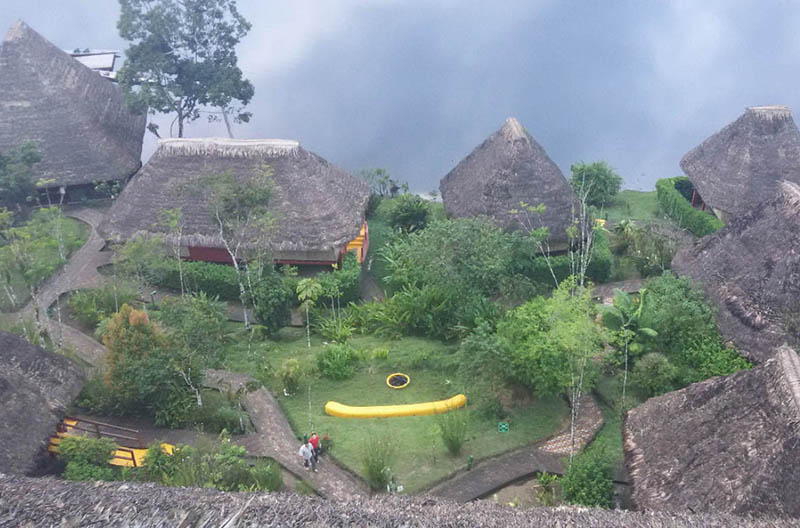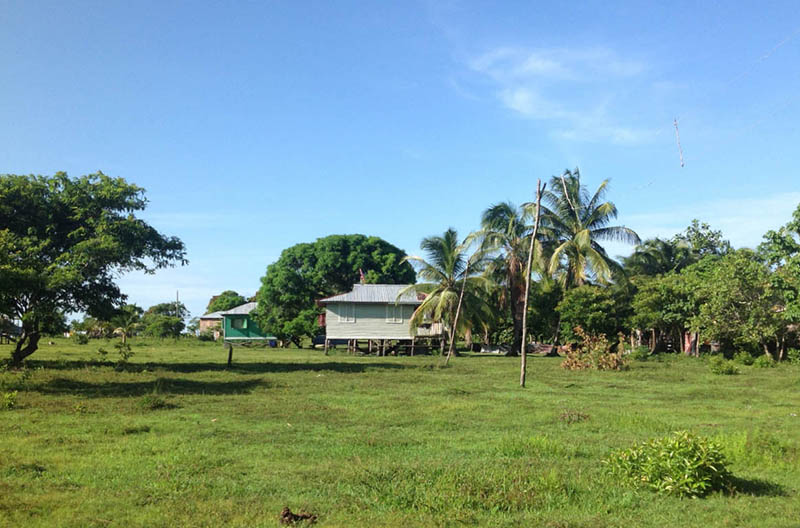Five types of measures for mitigating climate change in indigenous and tribal territories
b. Compensation for environmental services
Compensation for environmental services offers one of the main incentives for communities to take care of their forests and provides them with resources to do so. This compensation can take various forms, but payments for environmental services are the most common (Rosa, Kandel, and Dimas, 2004).
The Costa Rican, Ecuadorian, Guatemalan, Mexican, and Peruvian payment for environmental service programs have been the main mechanisms to compensate indigenous and tribal communities for their territories’ environmental services.36 Those programs have funded hundreds of indigenous and tribal communities to conserve more than four million hectares of forest(Rosa da Conceição, Borner, and Wunder, 2015; Figueroa et al., 2016; Arriagada et al., 2018a; Fischenich, 2018; Giudice et al., 2019; von Hedemann, 2019).37 These programs had positive environmental results.
The programs have also had favorable, though more limited, social impacts. They have achieved modest reductions in poverty, although household assets have yet to improve much; and the beneficiaries are largely satisfied with the results (Alix-García, Sims, and Yáñez-Paganas, 2015; Alix-García and Sims, 2017; Arriagada et al., 2018a; Arriagada et al., 2018b). Almost three quarters (74 percent) of Mexican communities that participated in the Payment for Environmental Services program reported that the program had improved their families’ welfare, although only 42 percent said it had increased their household income (Figueroa et al., 2016.) Ecuador’s Socio Bosque program has reduced the frequency of land conflicts in indigenous and Afro-Ecuadorian territories (Jones et al., 2020) and Peru’s National Forest Conservation Program (PNCB) has discouraged invasion of indigenous territories (Kowler et al., 2020).38
Most money from these programs goes to community-wide investments, although some goes to individual families. The community investments include secondary roads, schools, health facilities, community centers, scholarships, territorial management plans and patrols, and paying local people for forestry and agroforestry activities, among others (Borge and Martínez, 2009; de Kuning, 2011; Von Hedemann and Osorne, 2016; Arriagada et al., 2018b; DiGiano, 2018; Alix-García et al., 2019; Giudice et al., 2019).

Mamo from the Arhuaco People, Sierra Nevada of Santa Marta, Colombia.
Box 3 Socio Bosque: Ecuador pays indigenous and Afro-Ecuadorian communities to care for forests
In 2008, Ecuador’s Ministry of Environment created the Socio Bosque Program to conserve forests, montane vegetation, and mangroves, reduce carbon emissions and forest fires, and improve rural living conditions.
The program initially concentrated on paid private farmers to conserve forests, but later it shifted its emphasis to the country’s eleven indigenous peoples and Afro-Ecuadorians. The communities promise not to farm, log, or hunt in certain areas for twenty years. In exchange, Socio Bosque gives them payments to use for community activities; which can include everything from hiring community forest guards and clearing trails for land demarcation or fire barriers to building roads and community centers, and creating funds for credit, health, emergencies, education, and the elderly. To-date, 196 communities with over 240 000 inhabitants in different parts of the country have signed agreements, pledging to conserve 1 450 000 hectares of forest and other vegetation.
Studies about Socio Bosque have found positive results. While average annual deforestation rates in the districts where Socio Bosque worked declined from -1.09 percent between 2000 and 2008 to -0.18 percent between 2008 and 2016, deforestation rates in other districts rose during the same period. It is estimated that between 2008 and 2014 the program avoided the loss of 11 227 hectares of forest.
A survey of 501 indigenous and Afro-Ecuadorian program beneficiaries found that 96 percent approved of their communities’ participation in Socio Bosque. This almost unanimous approval was apparently not motivated by the economic benefits for the individual families interviewed, which were limited. People appreciated the benefits to the entire community. They mentioned that Socio Bosque reduced the invasion of their territories, improved the transparency and accountability of local organizations, increased participation in volunteer community activities, and helped to build local value chains.
Cultural aspects also stand out. The territories participating in Socio Bosque have used program funds to protect and restore churches and sacred sites and hold cultural events. The Shuar Arutam community invested in a School for Ancestral Traditional Knowledge. Mativaví-Salinas recovered a sacred site in a small forest remnant and San Miguel Negrero invested in a Marimba school, to maintain the Afro-Ecuadorian musical traditions.
Problems mentioned in the studies include lack of technical assistance, failure of credit funds, and internal conflicts over resource use. They note that even though many women participate in program activities, Socio Bosque made no specific effort to support initiatives of interest to women. SOURCE: Arriagada et al., 2018a; Cuenca et al., 2018; Eguiguren, Fischer, and Günter, 2019; Perefán and Pabón, 2019; Jones et al., 2020.

Socio Bosque: Ecotourism in the Kichwa Añangu Community, Ecuador.
Most programs pay communities to avoid forest clearing and harvesting of forest products in specific areas during an established period, which can vary between one and twenty years. However, there are also positive examples from Costa Rica, Guatemala, and Mexico, where the programs compensate communities for sustainable forest management activities and reforestation. Those activities helped make the efforts more sustainable and strengthened community cohesion (Von Hedemann and Osorne, 2016). The use of National Forest Conservation Program (PNCB) funds to finance agroforestry systems in Peru explained part of the reduction in deforestation the program achieved (Giudice et al., 2019).
One frequent concern is that payments for environmental services substitute (“crowd out”) voluntary community efforts and undermine social capital; that communities come to see forestry activities as a government responsibility and not something to do on their own initiative (Von Hedemann and Osorne, 2016; Wunder et al., 2020). So far, that does not seem to be the case, at least in Costa Rica and Mexico. In fact, the evidence suggests these programs have strengthened social capital and promoted volunteer efforts (Borge and Martínez, 2009; Rodríguez-Robayo, Ávila-Foucat and Maldonado, 2016; Alix-García et al., 2018; Alix-García et al., 2019).
If Latin America’s indigenous and tribal peoples received just USD 5 per hectare per year for the 200 million hectares of forest they care for where governments have recognized their tenure rights that would provide them more than USD 1 billion yearly. In comparison, so far, the public investments in these payment for environmental service programs has been rather modest. Mexico has invested the most, but even there they only invested USD 56 million per year on average between 2003 and 2011, of which indigenous communities received about 40 percent (Alix-García, Sims, and Yáñez-Pagans 2015). None of the other four countries has invested more than USD 10 million per year on payments to these groups (Von Hedemann and Osborne, 2016; El Telégrafo, 2019; FONAFIFO, 2019; MINAM, 2019).
The average payment per hectare per year varies markedly between programs. Peru pays only about USD 3 per hectare. Ecuador pays around USD 9; Mexico roughly USD 30; Costa Rica about USD 60, and Guatemala more than USD 100 (de Koning, 2011; Von Hedemann, 2016; Alix-García et al., 2019; FONAFIFO, 2019; MINAM, 2019).
Despite these instruments’ proven effectiveness and the growing threats to the territories’ forests, funding for these programs has tended to decline. There is an urgent need to expand the compensation for environmental services for these territories to a level that corresponds with the threats.39 Going forward, it would be important to promote programs that:
- Are designed with the participation of the communities involved (Kowler et al., 2020).
- Fit well with the communities’ cultures, institutions, and preferences.
- Compensate communities for having managed their forests well and create the conditions to maintain that management indefinitely, rather than paying to purchase specific environmental services, by covering the opportunity costs owners incur by not using the land for other uses (Shapiro-Garza, 2019; van Dam, 2019).
- Contribute to strengthening social capital, promote democratic practices, transparency and accountability, build human capabilities, improve forest quality, and incubate sustainable productive and commercial activities.
- Use technical assistance and accompaniment approaches that promote social participation, and don’t substitute for it, as well as new methods for creating and sharing knowledge (Segura-Warnholtz, 2014).
- Leverage government funds to obtain counterpart contributions from universities, NGOs, and subnational governments, who can implement more holistic and participatory approaches, and offer higher quality technical assistance and training (Shapiro-Garza, 2019).
- Align well with other public policies related to forestry and agroforestry production, food security, social protection, and educational and job opportunities for youth.

Miskito Indigenous Community, Krukira, on the north coast of the city of Bilwi, in the North Caribbean Coast Autonomous Region (RACCN), Nicaragua. (Ravaged in 2007 by Hurricane Felix, and again in 2020 by hurricanes Eta and Iota.)
- 36 The indigenous components of the REDD+ in the Colombian Amazon and in Acre, Brazil, could also be considered compensation for environmental services, although they are not payment for environmental services programs, since they do not condition payment on specific environmental outcomes.
- 37 This is about 10 percent of the titled indigenous or tribal land in the regions where these programs operate.
- 38 The Guyanese government is currently considering including indigenous communities in the “payment for results” scheme it negotiated with Norway. Under this scheme communities would receive payments based on the level of their carbon emissions from deforestation and forest degradation. This has yet to be approved, but one study based on data from fifteen titled communities estimates that each community would receive between 166 500 and USD 283 750 per year (between 2 080 and USD 3 550 per family). That would be multiple times these families’ current incomes, which vary between 300 and USD 600 per year (Overman et al., 2018).
- 39 In some countries these programs may also provide a relevant and flexible mechanism to channel emergency support to the indigenous and tribal communities affected by the COVID-19 pandemic.


